Goby fish are generally hardy, peaceful, reef-safe saltwater aquarium fish that will be model citizens in a community reef tank. This article will provide an overview of the 21 Best goby fish for a saltwater tank, along with some important care guide quick facts.
21 Best goby fish for a saltwater tank
- Neon goby
- Yellowline goby
- Sharknose goby
- Diamond watchman
- Pink spotted watchman
- Yellow watchman goby
- Gold head sleeper
- Railway sleeper
- Flagtail
- Orange stripe
- Pinkbar
- Steinitz
- Orange spot
- Yasha
- Hi Fin Red Banded
- Citron Clown
- Green clown
- Court Jester
- Two-spot
- Red head
- Eviota goby
Most of the goby fish on this list will show some degree of aggression towards others of the same species (or substantially similar species), so they are best kept as one per tank, unless you get a bonded pair or plan to try and bond a male/female yourself.
21 Best goby fish care guide quick facts chart:
| Common name | Genus species | Care difficulty | Community behavior | Reef safe | Adult size (length) | Minimum tank size |
|---|---|---|---|---|---|---|
| Neon Goby | Elacatinus oceanops | Beginner | Peaceful | Reef safe | 2 in. (5.1 cm) | 10 G (37.9 L) |
| Yellowline Goby | Elacatinus figaro | Beginner | Peaceful | Reef safe | 2 in. (5.1 cm) | 10 G (37.9 L) |
| Sharknose Goby | Elacatinus evalynae | Beginner | Peaceful | Reef safe | 2 in. (5.1 cm) | 10 G (37.9 L) |
| Diamond Watchman Goby | Valenciennea puellaris | Beginner | Peaceful | Reef safe | 6 in. (15.2 cm) | 30 G (113.6 L) |
| Pink Spotted Watchman Goby | Cryptocentrus leptocephalus | Beginner | Peaceful | Reef safe | 4 in. (10.2 cm) | 30 G (113.6 L) |
| Yellow Watchman Goby | Cryptocentrus cinctus | Beginner | Peaceful | Reef safe | 4 in. (10.2 cm) | 30 G (113.6 L) |
| Gold Head Sleeper Goby | Valenciennea strigata | Intermediate | Peaceful | Reef safe | 5.5 in. (14 cm) | 30 G (113.6 L) |
| Railway Sleeper Goby | Valenciennea helsdingeni | Beginner | Peaceful | Reef safe | 5.5 in. (14 cm) | 30 G (113.6 L) |
| Flagtail Shrimp Goby | Amblyeleotris yanoi | Beginner | Peaceful | Reef safe | 5.5 in. (14 cm) | 30 G (113.6 L) |
| Orange Stripe Prawn Goby | Amblyeleotris randalli | Beginner | Peaceful | Reef safe | 4.5 in. (11.4 cm) | 10 G (37.9 L) |
| Pinkbar Goby | Amblyeleotris aurora | Beginner | Peaceful | Reef safe | 4 in. (10.2 cm) | 10 G (37.9 L) |
| Steinitz Goby | Amblyeleotris steinitzi | Beginner | Peaceful | Reef safe | 5 in. (12.7 cm) | 10 G (37.9 L) |
| Orange Spotted Goby | Amblyeleotris guttata | Beginner | Peaceful | Reef safe | 3.5 in. (8.9 cm) | 10 G (37.9 L) |
| Yasha Shrimp Goby | Stonogobiops yasha | Beginner | Peaceful | Reef safe | 2.5 in. (6.4 cm) | 10 G (37.9 L) |
| Hi Fin Red Banded Goby | Stonogobiops nematodes | Intermediate | Peaceful | Reef safe | 2 in. (5.1 cm) | 10 G (37.9 L) |
| Citron Clown Goby | Gobiodon citrinus | Beginner | Peaceful | Reef safe | 2 in. (5.1 cm) | 10 G (37.9 L) |
| Green Clown Goby | Gobiodon atrangulatus | Beginner | Peaceful | Reef safe | 1.75 in. (4.4 cm) | 10 G (37.9 L) |
| Court Jester Goby | Koumansetta rainfordi | Intermediate | Peaceful | Reef safe | 3 in. (7.6 cm) | 10 G (37.9 L) |
| Two Spot Goby | Signigobius biocellatus | Advanced | Peaceful | Reef safe | 3 in. (7.6 cm) | 10 G (37.9 L) |
| Red Head Goby | Elacatinus puncticulatus | Intermediate | Peaceful | Reef safe | 2 in. (5.1 cm) | 10 G (37.9 L) |
| Eviota Goby | Eviota pellucida | Beginner | Peaceful | Reef safe | 1 in. (2.5 cm) | 5 G (18.9 L) |
Cleaner gobies
If you’re looking for the right goby fish to add to your saltwater tank, one of the first groups you should consider are the cleaner gobies. These gorgeous fish grow to be about 2-inches in length and are some of the most fun-to-watch fish species, because they will set up a cleaning station and pick parasites and scales off of your fish.
There are three commonly available cleaner species, generally sold as captive-raised or aquacultured individuals, because they will readily spawn in captivity.
Neon goby or Blue Neon
While each of the cleaners in this list have a neon line, this is the one sometimes called THE Neon Goby or the Blue Neon. Note that the blue line extends from the tip of the nose all the way to the tail, which is one way to distinguish it from the Sharknose.
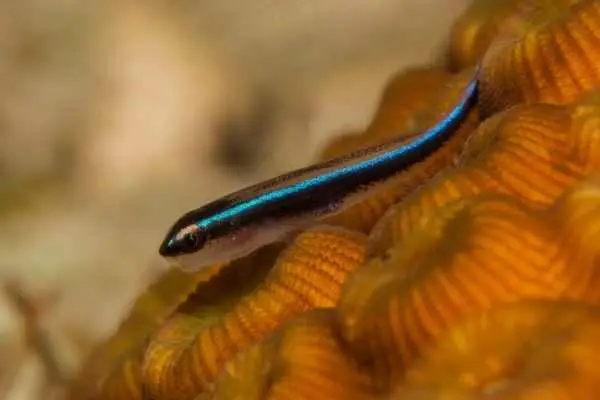
Yellowline goby
Once you see this fish, it’s not hard to see how they got the name Yellowline. This is another easy-to-care for fish that is suitable for just about any tank size, although the officially recommended minimum is 10-gallons, you could probably go a little smaller, if you wanted.

Sharknose goby
If you can’t decide whether you want a cleaner with a blue neon stripe or a yellow neon stripe, the Sharknose Goby is the fish for you. The Yellow line starts at the tip of the nose and runs along the head and then it transitions into a cool blue neon that is a little less vibrant than its blue cousin, but it still ads a pop of color to your tank.

Watchman Gobies and Sleeper Gobies
The Watchman and Sleeper Gobies are a group of saltwater aquarium fish that tend to spend their time perched on the sandy substrate, sifting or digging through. For this reason, they should be kept in a saltwater tank with a sand bed. Bare bottom tanks are not the right habitat for them.
Diamond watchman goby
The Diamond Goby is a fish who’s beauty will continue to amaze you, the more you see them. At first glance, they might seem humbly colored, but when you have enough time to truly appreciate them in your tank, you’ll see they are exquisitely detailed.
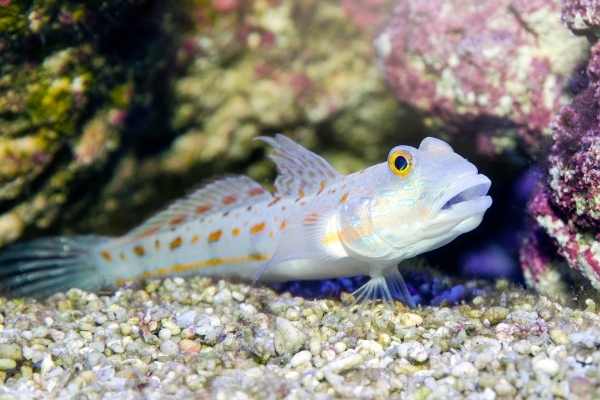
Pink spotted watchman
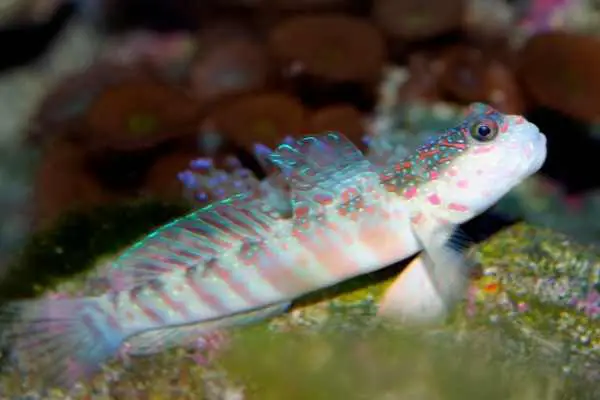
Yellow watchman goby
The Yellow Watchman Goby is a very popular species because of its bright yellow coloration (which sometimes trends to darker brown depending on the fish’s ‘mood/comfort’ in the tank, but it is also decorated with tiny jewel-like spots.
It is also a shrimp goby that tends to have a commensal relationship with a tunnel-building shrimp species, which is another one of the reasons for their popularity.

Gold head sleeper
The Gold Head sleeper goby is the only one of the sleepers on this list that is recommended for aquarium owners with at least an intermediate amount of experience. It will spend its days sifting through the sandy substrate looking for tiny invertebrates to eat.
When first introduced, it may be shy and picky about what it eats, so please watch closely to make sure it is getting enough to eat. The tell-tale sign of a starving fish is when you see a sunken in abdomen and the dorsal muscle (top of their back) behind their heads get thinner than their bony head. At that point, the fish has already starved for quite some time.

Sleeper Railway Glider

Striped or spotted shrimp or prawn gobies
This next group of goby fish I’m going to loosely categorize as the striped or spotted shrimp or prawn gobies. These fish are attractive on their own merit, but are generally most desired because of their tendency to pair up with one of the pistol shrimp.
Flagtail goby
It’s hard to tell from the image here, because the tail is hidden behind a rock, but the Flagtail Goby, which otherwise looks fairly similar to the Steinitz goby, has a beautiful, large, spade-like tail when it is fully displaying its fins.
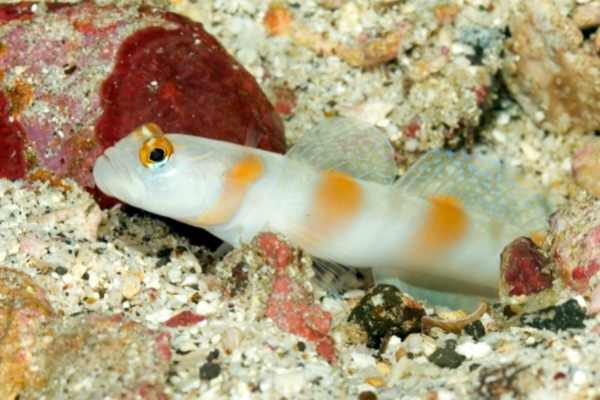
Orange stripe prawn goby
The Orange stripe prawn goby has prominent orange stripes that look like the bands of a Copperband butterflyfish, paired with a large eyespot on a relatively large, banner-like dorsal fin.
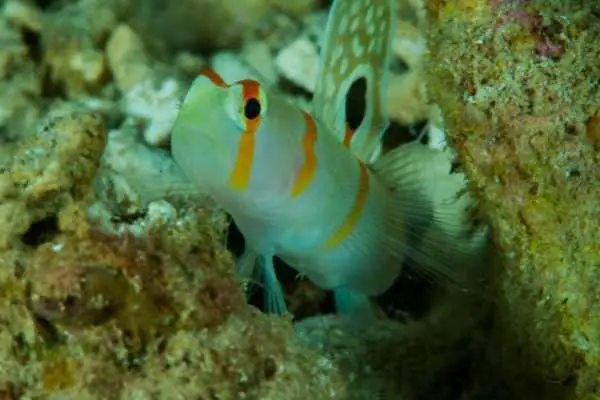
Pinkbar goby
Is the Pinkbar goby pink with white stripes or white with pink stripes? What sets this Goby fish apart is the very prominent salmon-colored striations and the yellow tail.

Steinitz goby
The Steinitz goby is a little more drab than some of its cousins, but if you have a chance to get one that is paired up with a burrowing shrimp, you won’t be disappointed. It will command hours of entertainment for you and it will snag all of the people who visit your house.

Orange spotted goby
It’s not hard to see how the Orange Spotted Goby fish got its name. This hardy, reef-safe peaceful community fish would be considered mid-sized as one of the gobies on this list because it grows to about 3.5 inches in total length as an adult but the attractive orange spotted pattern and easy care is what makes them one of the best goby fish.
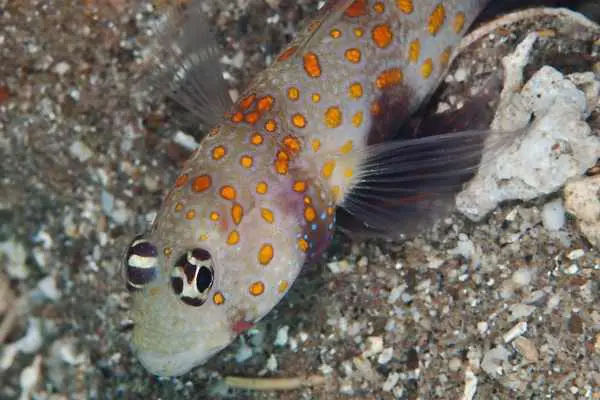
Hi-fin shrimp gobies
These next two goby fish are known for their own beautiful fins as well as their tendency to pair up with shrimp.
Yasha goby
The Yasha Goby, also sometimes called the Hi Fin White Yasha has a white colored body with orange stripes that run the length of the small fish’s body. It also has a gorgeous banner fin that it will show off, when comfortable.
Hi Fin Red Banded Goby
The Hi Fin Red Banded Goby has a yellow nose and eyes, with zebra-like striping and a long banner fin that is dark in color.
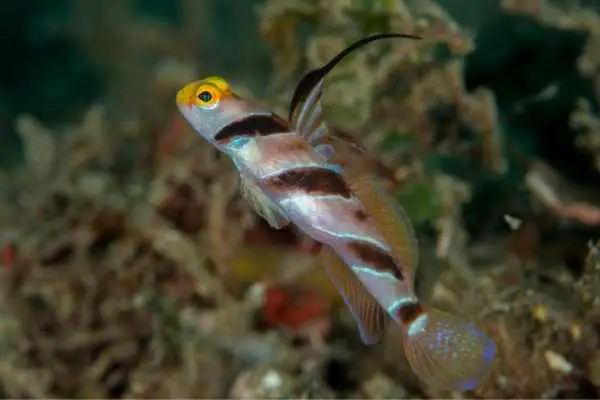
Clown gobies
The clown gobies are gorgeous and popular, for obvious reasons, but are the goby fish on this list that come with the biggest warning. On ocean reefs, these gobies generally live among SPS coral colonies. They perch on the branches, lay their eggs on the branches and even depend on the SPS corals themselves for some of their nutrition.
They don’t eat the coral polyps, per se, but the coral’s mucus is thought to be a significant and important part of their diet.
They also provide a bit of a service in that they help keep algae levels down as a result of their activities. But the point here is that even though they are considered reef safe, they can sometimes be enough of a nuisance to your prized corals to cause some damage.
If you’re excited to see this natural behavior and reef relationship and are willing to tolerate a little bit of risk, they are gorgeous animals and worth adding. However, if you think your spirit would turn into crushed coral to see anything happen to your prized SPS, you may want to skim this section and find another one of the best goby fish for your reef tank.
Citron clown goby
The Citron clown goby is yellow/orange in color with a few white stripes that mark up the face/head and sides. Be cautious and watch closely when you introduce them to be sure they’re not harassing your corals to the point of damage.
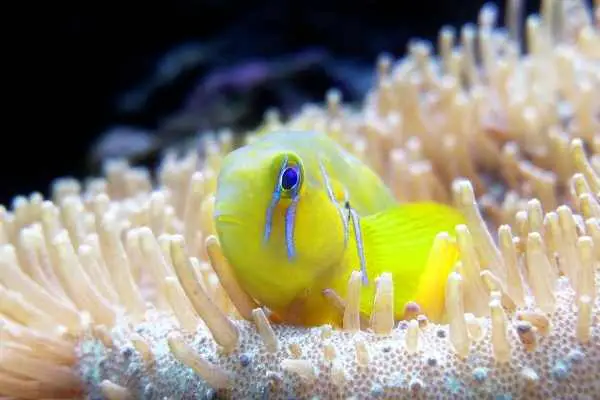
Green clown goby
The Green Clown Goby has a big round head, just like the other coral gobies with a mostly green body that has pink/orange highlights/stripes. This fish should be added to reef tanks with a bit of caution to make sure their behavior doesn’t cause too much damage to your coral colonies.
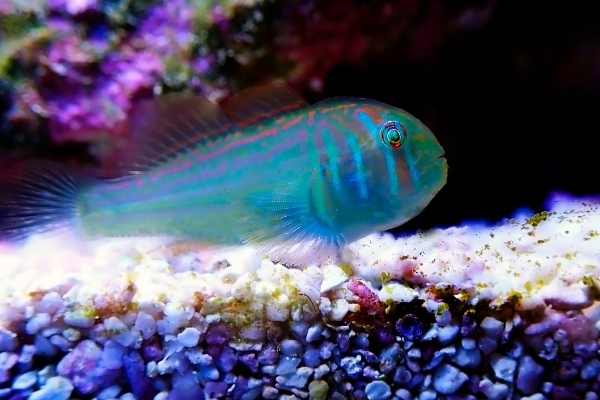
Other great goby fish for a saltwater tank
Rounding out the list of other great goby fish for a saltwater tank are a few more options that didn’t seem to really fit into the categories I created above. But just because they are silo-busters doesn’t mean you should consider them less. In fact, they may be some of the most popular gobies you will find.
Court Jester
Known for their small size and gorgeous colorations, the Court Jester goby is a sure-thing to put a smile on anyone’s face.

Two spot signal goby
The Two spot signal goby is one of the most famous of these best goby fish on the list. You probably recognize them from the picture below. They are are famous because their coloration patterns and swimming style are thought to mimic that of a much larger crab. The two large eyespots confuse would-be predators into thinking they are in for a big pinch, which keeps this bold fish safe on the reef floor.
The only challenge with these fish is that they are a bit more difficult to care for than most of the other gobies on this list and adults will show significant aggression with others of their species, if they are not a bonded male/female pair.
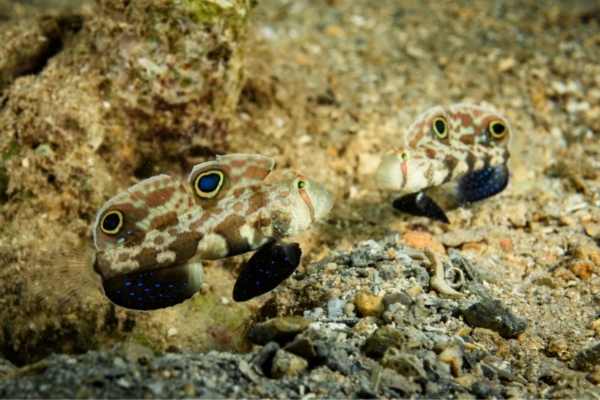
Redhead goby
The Redhead goby is the goby-lover’s goby. The main body of the fish is mostly transparent, with some darker mottling coloration to help it blend in and then the head has a burst of red and orange colors. The beauty is subtle but worth it.

Eviota goby
This is the smallest saltwater fish on the list, but the Eviota goby makes up for its diminutive size with gorgeous colors and and oversized personality.
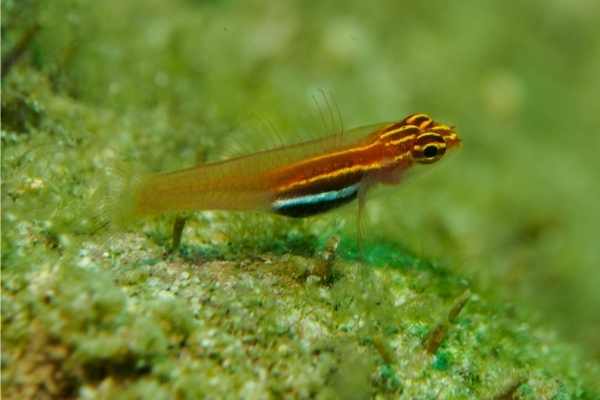
Goby fish compatibility
If you want to find some other great tank mates for these 21 Best goby fish for a saltwater tank, check out these other stocking guides for recommendations:
10-gallon tank saltwater fish recommendations
20-gallon saltwater tank fish stocking guide
30-gallon saltwater tank fish recommendations
Looking for a goby that isn’t on the list?
A lot of popular saltwater fish are commonly labelled ‘goby’ even though they belong to different families. Here are a few links to other popular fish care guides for fish that are commonly called gobies, but aren’t:
Conclusions
The 21 Best Goby Fish for a saltwater tank offer a range of great peaceful community fish options. The fish range in size from 1-inch to 6-inches in length and are suitable for most reef tanks since specific individuals have minimum tanks sizes of 5, 10 or 30-gallons depending on their relative size.
Their small size allows you to care for them in a smaller tank than comparably larger saltwater fish, but even in a larger reef tank, they add subtle character and charm that is sure to be a hit even in a larger system.

What to read next
Check out these other popular saltwater fish lists to find the right one for your tank to go with these best goby fish:
21 Best Algae-eating saltwater fish
15 Most colorful saltwater fish
20 Most popular saltwater fish



Leave a Reply